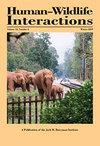Caring for the Circle of Life: Wildlife Rehabilitation and Sanctuary Care
IF 0.9
4区 环境科学与生态学
Q4 BIODIVERSITY CONSERVATION
引用次数: 3
Abstract
: In the United States alone, there are >5,000 state-licensed wildlife rehabilitators in addition to a multitude of other wildlife caregivers across rehabilitation and sanctuary settings. Wildlife rehabilitation and sanctuary care provide a unique lens from which to explore human– wildlife interactions. We examined the experiences of wildlife caregivers within a continuum of acute veterinary services, community-based rehabilitation, and sanctuary care to gain insight into wildlife caregiving and its implications for human–wildlife coexistence. Between 2016 and 2018, we completed in-depth interviews with 15 wildlife caretakers in Massachusetts, Maine, and New Hampshire, USA. In addition to the interviews, we observed 197 unique human–animal interactions during wildlife care. The overarching paradigm that emerged from our research was what we refer to as “caring for the circle of life.” Embraced within this paradigm were 5 themes: (1) entering and persevering in the circle of care; (2) honoring natural processes; (3) knowing and being known by the wild creature; (4) extending the circle of care; and (5) fulfillment. Wildlife rehabilitation and sanctuary care, in addition to providing medical assistance to animals in need, advance knowledge about individual species and contributes to increased public awareness regarding wildlife conservation and human–wildlife coexistence.关爱生命之圈:野生动物康复和保护区护理
仅在美国,就有超过5000名国家许可的野生动物康复人员,此外还有许多其他野生动物护理人员,遍布康复和保护区。野生动物康复和保护区护理提供了一个独特的镜头,从中探索人类与野生动物的相互作用。我们研究了野生动物护理人员在急性兽医服务、社区康复和保护区护理连续体中的经验,以深入了解野生动物护理及其对人类与野生动物共存的影响。2016年至2018年期间,我们对美国马萨诸塞州、缅因州和新罕布什尔州的15名野生动物饲养员进行了深入采访。除了访谈之外,我们还观察到在野生动物护理过程中197种独特的人与动物相互作用。从我们的研究中得出的最重要的范例是我们所说的“关心生命的循环”。这种模式包含5个主题:(1)进入并坚持护理圈;(2)尊重自然过程;(三)认识并被野生动物认识的;(4)延伸关怀圈;(5)实现。野生动物康复和保护区护理,除了向有需要的动物提供医疗援助外,还增进了对个别物种的了解,并有助于提高公众对野生动物保护和人类与野生动物共存的认识。
本文章由计算机程序翻译,如有差异,请以英文原文为准。
求助全文
约1分钟内获得全文
求助全文
来源期刊

Human–Wildlife Interactions
Environmental Science-Nature and Landscape Conservation
CiteScore
2.80
自引率
0.00%
发文量
0
审稿时长
11 weeks
期刊介绍:
Human–Wildlife Interactions (HWI) serves the professional needs of the wildlife biologist and manager in the arena of human–wildlife conflicts/interactions, wildlife damage management, and contemporary wildlife management. The intent of HWI is to publish original contributions on all aspects of contemporary wildlife management and human–wildlife interactions with an emphasis on scientific research and management case studies that identify and report innovative conservation strategies, technologies, tools, and partnerships that can enhance human–wildlife interactions by mitigating human–wildlife conflicts through direct and indirect management of wildlife and increased stakeholder engagement. Our intent is to promote a dialogue among wildlife professionals concerning contemporary management issues. As such, we hope to provide a repository for wildlife management science and case studies that document and share manager experiences and lessons learned.
 求助内容:
求助内容: 应助结果提醒方式:
应助结果提醒方式:


